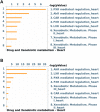Transcriptional Regulation of Drug Metabolizing CYP Enzymes by Proinflammatory Wnt5A Signaling in Human Coronary Artery Endothelial Cells
- PMID: 34079452
- PMCID: PMC8165381
- DOI: 10.3389/fphar.2021.619588
Transcriptional Regulation of Drug Metabolizing CYP Enzymes by Proinflammatory Wnt5A Signaling in Human Coronary Artery Endothelial Cells
Abstract
Downregulation of drug metabolizing enzymes and transporters by proinflammatory mediators in hepatocytes, enterocytes and renal tubular epithelium is an established mechanism affecting pharmacokinetics. Emerging evidences indicate that vascular endothelial cell expression of drug metabolizing enzymes and transporters may regulate pharmacokinetic pathways in heart to modulate local drug bioavailability and toxicity. However, whether inflammation regulates pharmacokinetic pathways in human cardiac vascular endothelial cells remains largely unknown. The lipid modified protein Wnt5A is emerging as a critical mediator of proinflammatory responses and disease severity in sepsis, hypertension and COVID-19. In the present study, we employed transcriptome profiling and gene ontology analyses to investigate the regulation of expression of drug metabolizing enzymes and transporters by Wnt5A in human coronary artery endothelial cells. Our study shows for the first time that Wnt5A induces the gene expression of CYP1A1 and CYP1B1 enzymes involved in phase I metabolism of a broad spectrum of drugs including chloroquine (the controversial drug for COVID-19) that is known to cause toxicity in myocardium. Further, the upregulation of CYP1A1 and CYP1B1 expression is preserved even during inflammatory crosstalk between Wnt5A and the prototypic proinflammatory IL-1β in human coronary artery endothelial cells. These findings stimulate further studies to test the critical roles of vascular endothelial cell CYP1A1 and CYP1B1, and the potential of vascular-targeted therapy with CYP1A1/CYP1B1 inhibitors in modulating myocardial pharmacokinetics in Wnt5A-associated inflammatory and cardiovascular diseases.
Keywords: Wnt5A; cardiac vascular endothelial cells; inflammation; pharmacokinetic pathways; transcriptome profiling.
Copyright © 2021 Skaria, Bachli and Schoedon.
Conflict of interest statement
The authors declare that the research was conducted in the absence of any commercial or financial relationships that could be construed as a potential conflict of interest.
Figures
Similar articles
-
Wnt5A/Ryk signaling critically affects barrier function in human vascular endothelial cells.Cell Adh Migr. 2017 Jan 2;11(1):24-38. doi: 10.1080/19336918.2016.1178449. Epub 2016 May 9. Cell Adh Migr. 2017. PMID: 27159116 Free PMC article.
-
IL-4 Causes Hyperpermeability of Vascular Endothelial Cells through Wnt5A Signaling.PLoS One. 2016 May 23;11(5):e0156002. doi: 10.1371/journal.pone.0156002. eCollection 2016. PLoS One. 2016. PMID: 27214384 Free PMC article.
-
Expression of cytochrome P450 (CYP) enzymes in human nonpigmented ciliary epithelial cells: induction of CYP1B1 expression by TCDD.Invest Ophthalmol Vis Sci. 2009 Jul;50(7):3099-105. doi: 10.1167/iovs.08-2790. Epub 2009 Mar 25. Invest Ophthalmol Vis Sci. 2009. PMID: 19324859
-
Poly(ADP-ribose) Polymerase (PARP) and PARP Inhibitors: Mechanisms of Action and Role in Cardiovascular Disorders.Cardiovasc Toxicol. 2018 Dec;18(6):493-506. doi: 10.1007/s12012-018-9462-2. Cardiovasc Toxicol. 2018. PMID: 29968072 Review.
-
Xenobiotic-metabolizing cytochrome P450 enzymes in the human feto-placental unit: role in intrauterine toxicity.Crit Rev Toxicol. 1998 Jan;28(1):35-72. doi: 10.1080/10408449891344173. Crit Rev Toxicol. 1998. PMID: 9493761 Review.
Cited by
-
Identification and verification of disulfidptosis-related genes in sepsis-induced acute lung injury.Front Med (Lausanne). 2024 Aug 28;11:1430252. doi: 10.3389/fmed.2024.1430252. eCollection 2024. Front Med (Lausanne). 2024. PMID: 39262873 Free PMC article.
References
LinkOut - more resources
Full Text Sources
Molecular Biology Databases


